VVAM Newsletter 57 – 1995
Utrechtseweg 232 6862 AZ Oosterbeek The Netherlands
NEWSLETTER No. 54, May 1994
Translated by Cathrien and Peter Clark
Representative in Great Britain: Mr. E.E. Shaw, 298 Totnes Road Paignton – Devon TQ4 7HD Tel. 0803-553616
From the editors
With the 50th commemoration of operation Market Garden still fresh in our memories, preparations are already under way for the next great anniversary, that of the liberation of the Netherlands in May 1945. Following the failure of the Battle of Arnhem, the Germans forced the inhabitants of the southern Veluwe region to leave their homes. There then followed the construction by the Germans of a formidable defensive line, which included trenchsystems and underground command posts, and the area was systematically plundered. Allied bombardments from the south caused even greater damage than the fighting in September 1944.
When Allied troops entered Arnhem and surroundings in April 1945 they found a destroyed and empty town. The former inhabitants, who had no other choice but to celebrate the liberation elsewhere in the Netherlands, were only able to return to their homes over the next few months.
Our society’s programme of activities for this year will also devote attention to the liberation.
15th General Members Meeting
You are invited to attend the 15th General Members Meeting of the Society of Friends of the Airborne Museum Oosterbeek. The meeting, which will include the Annual Meeting, will be held in the ZALENCENTRUM LEBRET (Lebretweg 51 in Oosterbeek, tel. 085-333168) on Saturday 1 April next, starting at 2 pm.
The agenda is as follows:
1. Opening
2. Minutes of the General Members Meeting of 9 April 1994
3. General Report 1994
4. Financial Report 1994
5. Audit Committee Report
6. Budget for 1995
7. Election of Officials
8. Appointment of reserve member to the Audit Committee
9. Questions
10. Closure of the meeting.
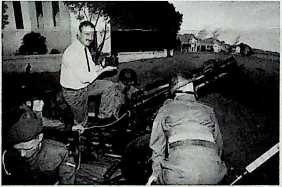
The curator of the Airborne Museum, Berry de Reus, fits an original sight to the 75mm Pack Howitzer in the relevant diorama in the museum. This sight, the only survivor from the 24 which were taken to Arnhem, comes from a private collection.
(Photo: Robert Voskuil)
Information on agenda point 7. Messrs Chr. van Roekel and A.
-Hofman have come to the end of their term of office but both have declared themselves available for re-election. Article 8 of the statute allows for the proposal of alternative candidates. In this event, a written nomination should reach the secretary (C/O Utrechtseweg 232, 6862 AZ Oosterbeek) at least 10 days before the meeting, signed by a minimum of 10 members and accompanied by a declaration of availability from the candidate. The candidate must be a Society member and an adult.
Papers relating to financial matters will be sent to you separately. The Audit Commission report will be available for perusal half an hour before the meeting begins. After the meeting the film “De Bevrijding van Nederland’ (The Liberation of the Netherlands) will be shown. This documentary, dating from 1945, was made by the Canadian Army Film Service.
General Report 1994
We began the year with 1127 members. During 1994 15 people cancelled their membership, 20 people had their membership withdrawn through non-payment of subscriptions, and eight members died.
Membership was increased by 152, including two British and six Dutch ‘life members’. We ended the year with 1236 members.
Those who passed away were the ladies Mrs. H. van der Vlist, Mrs. J. Klaassen-Opendorp, Mrs. G.H.A. Gouda Quint and Mrs. J.F. van Hasselt, and the gentlemen Mr. H.P. Veenhuysen, Mr. H. van Drumpt, Mr. J. W. Regtering and Mr. H.
Blankenstijn Jr.
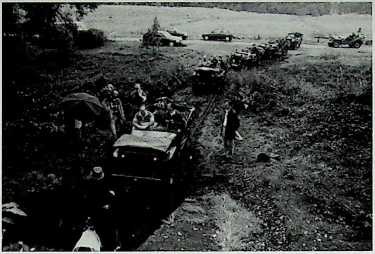
Saturday 27 August 1994. After 50 years jeeps once again stand ready to drive through the tunnel under the Arnhem-Utrecht railway embankment. See the account in the previous Newsletter.
(Photo: Berry de Reus)
The Newsletter’s new design exceeded all expectations and four issues with associated Ministories were published. To coincide with the 50th anniversary of the Battle of Arnhem the 56th edition was given a front page in colour, and contained twice the normal number of pages. The schools project, organised by our society for many years, had to be adapted due to the renovation of the Airborne Museum. Dutch and English versions of the new folder appeared with an exceptional photograph of the Rhine bridge in Arnhem, taken after the Battle of Arnhem, on its cover. The 4,000 photo sheets – each pupil receives a copy with his/her folder – were provided free of charge by our printer, Linders-Adremo of Oosterbeek. Great Dutch and British interest was shown in our schools project in 1994. It appears to be an important tool in informing today’s youth of the events of September 1944.
By far the greatest gift from our society to the Airborne Museum last year was undoubtedly the financing of the new diorama depicting the artillery positions near the Old Church in Oosterbeek. The official hand-over took place on 18 May during the re-opening of the renovated and modernised museum.
Other gifts to the Airborne Museum included a portable overhead projector, protective covers for transportable dioramas, a Royal Enfield motorcycle and a set of original wheels for the Airborne handcart, itself presented by the King’s Own Scottish Borderers.
The society was promised 5,000 guilders for the schools project from the SEMO (Stichting Fondsenwerving Militaire Oorlogs- en Dienstslachtoffers – a trust which acquires funds for military war and service victims). A sum of 10,000 guilders from the profits from the sale of telephone cards will be presented to the museum by the ‘VW Arnhem, de Zuid-Veluwe and de Liemers’ (regional tourist board). This money will also be used for the schools project.
Last year many more propaganda/sales stands were present at various events, partly in conjunction with the 50th anniversary. They were to be seen at such events as the Netherlands Royal Air Force Open Days at Leeuwarden, the Heideweek at Ede, the Airborne Cycle tour at Doorwerth, the ‘Resistance day at Nunspeet, the Airborne Walk at Oosterbeek, the Societies market at Oosterbeek, the gathering of the veterans in Arnhem, the parachute drop on the Ginkelse Heide at Ede, the Polish commemoration at Driel, the veterans march in Arnhem, the Pegasus walk at Lunteren and the commemoration of the liberation of Vucht. Profit for the society and for the museum amounted to more than 25,000 guilders. Every year the society provides a fitting gift for the schoolchildren who place flowers on the graves during the memorial service at the Airborne Cemetery. This year they were given a copy of the booklet ‘De Tommies Komen’ (The Tommies are Coming), a society publication. The British and Polish children who took part each received a Pegasus badge.
Thanks to the sponsorship of R.Z.R. Zorgverzekeraar from Doorwerth (an insurance company), the society was able to present all the participating schools with a copy of the video ‘We’ll See You In September’. Last year the society made a fervent plea for the protection of the allied trenches from 1944 that are still to be found in the Hemelse Berg park and at the Bilderberg in Oosterbeek, and at Papendal in Arnhem. The Arnhem and Renkum municipalities were requested to place these items on the protected list. Renkum municipality reacted positively and took measures to ensure their continued existence; Arnhem municipality thought it sufficient to refer us to the owners of the areas in question.
An excursion was held on 18 June with the role of the 1st Airlanding Light Regiment Royal Artillery as its subject. The fighting that took place at Paasberg in Oosterbeek was also dealt with during the excursion. A theme afternoon was held in the Concert Hall in Oosterbeek on 17 December. Marcel Anker, one of our members, gave a lecture on the fate of C company, 2nd Parachute Battalion, after which the video film ‘We’ll See You in September’ was shown. On reflection one could say that 1994 was a very busy year, but it was also an extremely successful year.
(J.M. de Langen, secretary)
A reminder from the Treasurer
Members who have not paid their 1995 annual subscriptions are now asked to do so as soon as possible. Individual membership costs 20 guilders per year, family membership 30 guilders.
Airborne Museum receives 95,000 visitors
The Airborne Museum received 95,000 visitors during 1994, the year of the 50th commemoration of the Battle of Arnhem. Of these, 92,000 were paying visitors, while 2,000 veterans and 1,000 members of the Society of Friends visited the museum free of charge.
The wide publicity given to the anniversary ensured that 1994 was a top year for the museum. September alone saw 22,500 paying visitors, making this the busiest month in the museuni’s history.
Shop and store rebuilt
The total renovation of the Airborne Museum was rounded off in November and December last year when the shop and store underwent extensive rebuilding. The shop, which was housed for a time in the new exposition room in the cellar, has now been given its permanent spot next to the cloakroom on the ground floor.
The Hartenstein’s former wine cellar is now a store. Provisions for ensuring good ventilation and humidity control have been installed.
Exhibition
The Airborne Museum will be exhibiting the paintings and-drawings it received as gifts during the 50th commemoration of the Battle of Arnhem in September 1994 from 16 February until 19 March. The museum is also organising an exhibition entitled ‘De Bevrijders’ (The Liberators); it will run from 6 April until 1 October 1995. The exhibition, which is being held in connection with the 50th anniversary of the liberation of the Netherlands, will show Allied uniforms and equipment dating from the 1945 period.
Book Fair
The annual Book Fair will be held in the Airborne Museum on 22 April next, where secondhand books about World War II will be on sale. The experiences of previous years lead us to believe that this too will be a very busy day.
Gift of an extremely rare book
The Airborne Museum recently received a number books on World War II from a private donor. The collection contained one of the rarest books ever written about the Battle of Arnhem, the paperback
‘Five Days in Hell’ by Jack Smyth.
The author, a Reuter correspondent at the time, landed on the Ginkelse Heide with the 4th Parachute Brigade on 18 September 1944. He was wounded during the subsequent fighting and taken prisoner. The book, which incidentally doesn’t always adhere to the historical facts, was published in London in 1956.
‘ARNHEM, The Battle Remembered’
The 50th anniversary of the Battle of Arnhem led to the publication of a number of new books to do with
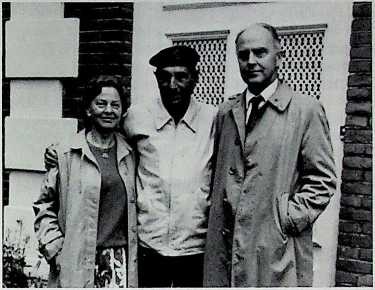
Former glider pilot Louis Hagen, author of the book ‘Arnhem Lift’, stands in front of No. 8 Stationsweg together with Ans and Sander Kremer. Hagen fought in and around this house in Oosterbeek, the then home of the Kremer family, for several days in September 1944. His visit to Oosterbeck-dtiring September last year was reported in the previous Newsletter.
(Photo: Robert Voskuil)
the battle. One such is the book ‘ARNHEM, The Battle Remembered’, by Robert Jackson. This book not only deals with ‘Arnhem’, it also covers the complete Market Garden operation.
The author begins with an analysis of the military situation in the period prior to 17 September 1944. There then follows a summary of the history of the various British Airborne operations and the lessons learned from them. He goes on to describe the Market Garden operational plan, the German military situation and the preparatory bombardments.
The day to day military operations, both Allied and German, are described in the next nine chapters. Ample attention is given to the daily air operations, including those of the Luftwaffe. Besides the general military story there are a number of eye-witness accounts.
Despite the complicated nature of the operation the author has succeeded in producing a clear and easy to read summary. The book is lavishly illustrated with photographs and maps, although it has to be said that more care could have been paid to some of the captions. The book comprises 184 pages and contains a list of notes and a literature list.
‘ARNHEM, The Battle Remembered1 was published in 1994 by Airlife Publishing Ltd., Shrewsbury, and costs £ 19.95.
Special edition of ‘Arnhem de Genoeglijkste’ (Arnhem the Most Pleasant)
Last September the Arnhem Historical Society ‘Prodesse Conamur’ published a special edition of its magazine, ‘Arnhem de Genoeglijkste’, containing articles about the September 1944 period.
In it, W.H. Tiemens has written about Tex Banwell and Hendrika van der Vlist, A.S. Stempher about ‘Een bijzonder weekeinde in September 1944’ (An extraordinary weekend in September 1944), G.H. Maassen about the ‘Poolse para’s op de Johannahoeve, dinsdag 19 September 1944′ (Polish paras at Johannahoeve, Tuesday 19 September 1944), F.R. Ranft about ‘Contacten in oorlogstijd’ (Contacts in wartime), P.R.A. van Iddekinge about the Arnhem bridge and A.S. Stempher about the evacuation of Arnhem.
Copies of this special edition are still available, price 5 guilders.
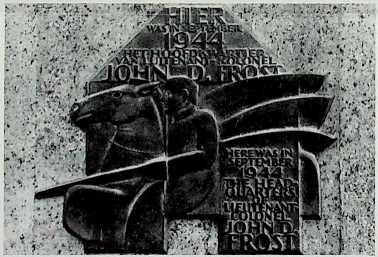
Last September a plaque was affixed to the wall of the Inland Revenue Office at the Rhine bridge in Arnhem, close to the spot where Lieutenant-Colonel John Frost’s headquarters ivas located in September 1944. (Photo: Berry de Reus)
Disappointing ‘Setback’
It is actually with great reluctance that I do this, but as one of the Newsletter’s editors I feel it my duty to make the readership aware of yet another new book about the Battle of Arnhem.
Some time has passed since Bert Kerkhoffs from Arnhem took it into his head to pick up his pen again and write something about September 1944. He even managed to get hold of a publisher as well, and the book duly appeared under the title ‘ARNHEM 1944 – Slag van de TEGENslag’ (ARNHEM 1944 – Battle of the Setback).
Kerkhoffs is one of those who is not exactly buckling under the burden of an excess of knowledge on the events of 50 years ago, and because of this the book is full of nonsense, flights of fancy, irrelevant facts and, worst of all, he doesn’t always tell the truth. I’ll give a few examples.
The author claims to have spoken to the former ‘Hohere SS-und Polizeifuhrer’ Hanns Albin Rauter after the war, and as proof of this he has published part of the text written by the war criminal himself. This text, however, is lifted direct from the Boeree collection, which is housed in the Arnhem Municipal Archives. It was in fact Boeree who spoke to Rauter, not Kerkhoffs!
According to the author himself he also interviewed the Polish General Sosabowski in 1949: ‘A soldier with dark eyes and a bristling moustache’. The General did indeed wear a moustache in September 1944, but this was not the case five years later. Did Kerkhoffs really talk to Sosabowski? Well of course not, no more than he spoke to Rauter and Eisenhower (Yes, Kerkhoffs even claims to have spoken to the last named as well).
About the Poles who landed at Driel on 21 September 1944, Kerkhoffs writes: ‘at Driel…the Polish parachutists were fired on by the British’… ‘because they wore different uniforms and berets’. There were no British at Driel, neither Airborne nor any other British unit. Besides this the Polish and British uniforms were identical, and at the time in question the Poles were, quite understandably, wearing helmets, NOT their grey berets.
Kerkhoffs’ finest piece of codswallop concerns the ‘American operators of the 1st British Airborne Division’s radio equipment’ who, after 50 years of research and despite assistance from ‘Colleagues in America, England, Canada and Poland’ are, and remain, untraceable. The retired Arnhem journalist obviously smelt an interesting tale somewhere in the far distance, but didn’t have the foggiest idea of where to go looking for the facts. American radio teams were indeed involved in the fighting, but they had nothing to do with the regular British signals troops. Why they were unable to carry out their specific tasks is clearly explained in the brochure “Calling ‘Sunray’! – de verbindingen tijdens de Slag om Arnhem, September 1944” (“Calling ‘Sunray’! – communications during the Battle of Arnhem, September 1944”), which was produced for the like- named exhibition held at the Airborne Museum ‘Hartenstein’ (1991). The names of these Americans are known.
I could go on like this forever and ever.
In view of all this I, as Renkum municipal archivist, would have liked to discuss this book with Kerkhoffs, but he refuses any discussion on the grounds that I was born after the war . . . Likewise, the inhabitant of Arnhem has no desire to be grilled about his publication by the Arnhem municipal archivist. The reasons are perfectly clear. Let me end by saying that not one of the photographs in the book is accredited. That in itself says enough about the standard of what is written, about the author and about the publisher.
In short, don’t buy the book, but if you do, don’t bother reading it, just consign it to the bookshelf. Should you, however, despite all warnings, still be tempted to acquaint yourself with the contents, then simply take everything you read with a big pinch of salt!
(Geert Maassen)

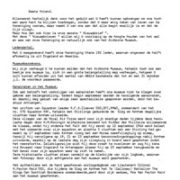
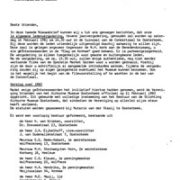
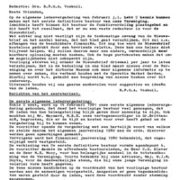
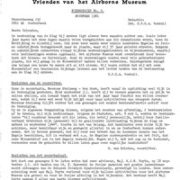
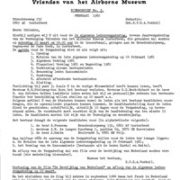
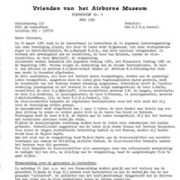
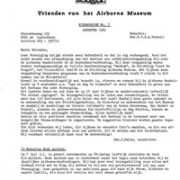
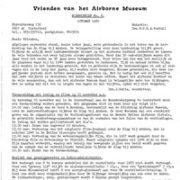
Plaats een Reactie
Vraag of reactie?Laat hier uw reactie achter.